Wildgoose Outwash Deposit Provincial Park Management Statement
This document provides policy direction for the protection, development and management of Wildgoose Outwash Deposit Provincial Park and its resources.
Approval statement
I am pleased to approve this Interim Management Statement for Wildgoose Outwash Deposit Provincial Park (P1610). Ontario’s Living Legacy Land Use Strategy (OMNR 1999) identified this area as a nature reserve class provincial park. This provincial park was regulated under the Provincial Parks Act in April 2005 (O. Reg. 180/05).
This Interim Management Statement provides direction for the protection and custodial management of Wildgoose Outwash Deposit Provincial Park.
Paul Bewick
Zone Manager
Northeast Zone
Ontario Parks
Date: December 12, 2006
1.0 Introduction
Wildgoose Outwash Deposit Provincial Park is a nature reserve class provincial park. The park is located approximately 27 kilometres south of Matheson and 14 kilometres east of the town of Ramore (Figure 1). Wildgoose Outwash Deposit Provincial Park contains 1198 hectares of Crown land regulated under the Provincial Parks Act (1990) (O. Reg. 180/05) (Figure 2).
This nature reserve class park was selected to represent distinct glacial outwash deposits and landforms within this region of the province. The park may provide opportunities for education and research to benefit present and future generations.
1.1 Objectives
Wildgoose Outwash Deposit Provincial Park will be managed consistent with the two main objectives for nature reserve class provincial parks:
Protection: To protect provincially significant elements of the natural and cultural landscapes of Ontario.
Heritage Appreciation: To provide opportunities for exploration and appreciation of the outdoor natural and cultural heritage of Ontario.
2.0 Management context
The purpose of this Interim Management Statement (IMS) is to provide direction to ensure the custodial management of park resources. Future park planning may be undertaken as required to provide direction on significant decisions regarding resource stewardship, development, operations and permitted uses.
Park management will follow direction from:
- Provincial Parks Act (1990) and regulations
- Ontario’s Living Legacy Land Use Strategy (OMNR 1999), policy clarification amendments (OMNR 2000) and related direction
- Ontario Provincial Parks Planning and Management Policies (OMNR 1992) and updates
- Crown Land Use Policy Atlas (OMNR 2004a).
In addressing custodial management obligations to protect park values and ensure public health and safety, Ontario Parks will ensure that policy and Environmental Assessment Act (1990) requirements are implemented.
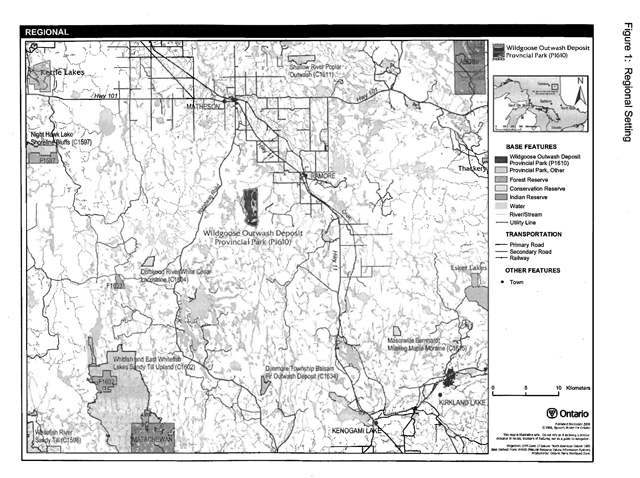
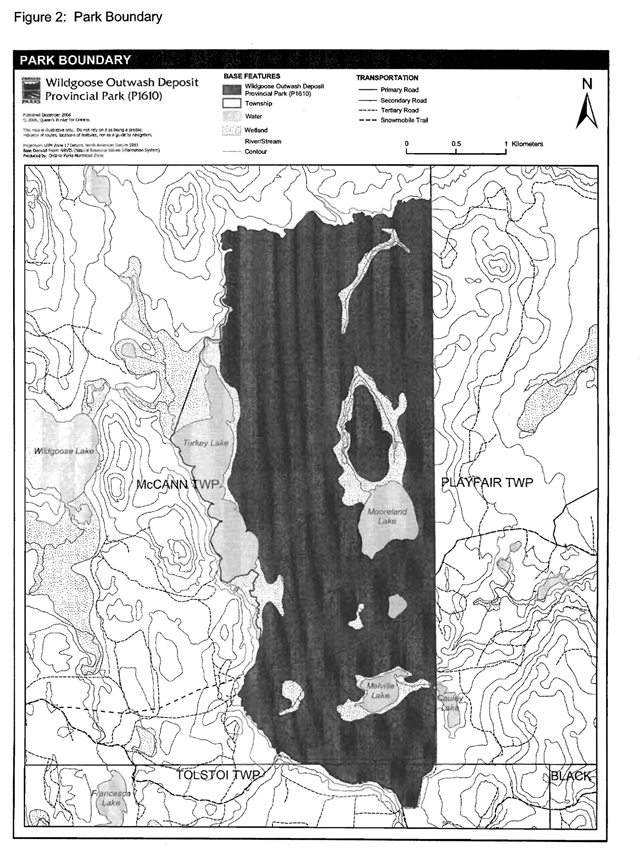
2.1 Environmental assessment
As part of the Ministry of Natural Resources (MNR), Ontario Parks is a public sector agency which is subject to the Environmental Assessment Act (1990). Management of this nature reserve provincial park will be carried out in accordance with legislation, policies and MNR’s A Class Environmental Assessment for Provincial Parks and Conservation Reserves (OMNR 2005).
3.0 Park features and values
Wildgoose Outwash Deposit Provincial Park protects representative ecosystems and landforms in Ecodistrict 3E-6. The park is dominated by even-aged stands of white birch, spruce, Jack pine, and aspen. The site is drained by the Wildgoose River and contains four lakes. Muskeg, tamarack and cedar swamps, and several fens and bogs are located within the park.
3.1 Geological features
Wildgoose Outwash Deposit Provincial Park is mostly within the 2.75 to 2.67 billion year old western Abitibi Subprovince in the Archean Superior Province of the Precambrian shield. The park also overlies the northernmost area of the Cobalt Embayment which is a part of the Paleoproterozoic 2.4 to 2.2 billion year old Huronian Supergroup of the Southern Province. The bedrock consists mainly of numerous basalt flows of the Kinojevis North supracrustal assemblage of the Abitibi greenstone belt. The Cobalt Group conglomerate occupies about 20 percent of the park. A small portion of the park contains a diabase intrusion of uncertain affinity.
The representation of these geological environments within the park contributes to the conservation of the Early Archean Basement
, Late Archean Volcanic Islands and Sedimentary Basins
and Early Aphebian Huronian Stable Platform
earth science themes (Davidson 1981).
Sandy ground moraine till thinly covers the north half of the park. This till was deposited approximately 11,000 years ago by the southward advancing Superior Lobe of the Late Wisconsinan continental ice sheet. The till in the south half is overlain or replaced by deltaic sand. These glaciofluvial sediments were deposited approximately 9,500 years ago into proglacial Lake Barlow during the northward recession of the Superior Lobe. The representation of these features contributes the conservation of the Quaternary Algonquin Stadial
and Timiscaming Interstadial
environmental themes (Davidson 1981).
Within the Ontario Provincial Park system, the bedrock geology of the park has regional to provincial significance in its representation of the Kinojevis North assemblage of the Abitibi greenstone belt. The Gowganda Formation in the park is regionally significant for its position at the limit of Proterozoic sedimentation on the Archean craton. The park contains a provincially significant moderately broken outwash deposit with moderate amounts of relief (Blackburn 2004).
3.2 Biological features
Wildgoose Outwash Deposit Provincial Park is located in Northeastern Ontario, Ecoregion 3E, Ecodistrict 3E-6.
Species inhabiting or using the area are typical of those found within the Boreal Forest. Moose wintering and feeding areas, as well as coolwater fisheries habitat (Ritchie and Thompson 1998), also exist in the area.
The park contains 14 landform-vegetation types and ten ecosite types. The landscape is dominated by even-aged stands of white birch, spruce, Jack pine, and aspen. The park contains a wide range of habitats, from upland to lowland communities. The forest stands are highly stratified by age class (0 to 120 years) and species composition (nine ecosite representations) (Aikins, 2003).
The park contains four lakes (Turkey, Mooreland, Melville and one unnamed lake), a portion of the Wildgoose River, and various wetland communities. Turkey Lake is surrounded by lush shoreline fens and is 72.5 hectares in size. This lake is a coolwater fishery, housing naturally occurring populations of yellow perch, speckled trout, sucker, cisco and pearl dace. The fishery has been supplemented with rainbow trout and lake herring since the late 1960s. Mooreland Lake is 32 hectares in size and is forested up to the waters’ edge. Melville Lake is 12 hectares in size and is surrounded by wetlands. Several lakes have now become black spruce bogs (Aikins, 2003).
Wetlands in the park range from open marsh to spruce bogs. These wetlands are characteristically associated with muskeg, tamarack, cedar, fens and spruce bogs. The substantial amount of wetlands in the park, typically species-rich communities, plays an important role in the biodiversity of the site (Aikins, 2003).
3.3 Cultural setting
A detailed survey and analysis of the cultural history and features of this park has not been completed to date.
Any future planning will be within the context of a provincial framework, A Topical Organization of Ontario History (OMNR 1974). In addition, updates and discussions with First Nations, other agencies and stakeholders may be carried out to identify cultural heritage values and features within the park and their significance. This information may be used to develop management guidelines to conserve and protect representative archaeological and historical values and features, or to provide direction for further research.
3.4 Recreation
The protection and maintenance of environmental quality and values are fundamental to the management of Wildgoose Outwash Deposit Provincial Park. Nature reserve policies ensure that nature is allowed to function freely, within the constraints of public safety and the need to protect values within and adjacent to the nature reserve.
Lakes and wetlands within the park and the section of the Wildgoose River flowing through the park are considered to have the most significant recreational potential. Low-intensity recreational uses, such as hiking, fishing, nature viewing and photography are complementary activities for this nature reserve (Carré 2003).
Although there are no recognized canoe routes within or next to the site, the Wildgoose Creek may provide canoeing opportunities.
A network of tertiary roads provides access to the southern portion of the park. These roads also provide access to the park’s water bodies.
Snowmobile trails in the area extend into the park, making use of the tertiary road network. These trails are listed on the Kirkland Lake District 2001 Snowmobile Trails map as L81 and L82 in McCann and Tolstoi townships (Carré 2002). These trails are associated with the Timiskaming Abitibi Trail Association. The Matheson Trail Masters Snowmobile Trail ends at the park boundary within Playfair Township (Carré, 2003).
4.0 Aboriginal uses
Wildgoose Outwash Deposit Provincial Park is located within the Treaty 9 area (1905). The park is approximately 35 kilometres from the Wahgoshing and Matachewan First Nations located to the northeast and southwest respectively.
Aboriginal communities within the Kirkland Lake District include Beaverhouse, Matachewan First Nation, Temagami First Nation and the Wahgoshing First Nation. During the boundary regulation process, consultation occurred with these Aboriginal communities. No Aboriginal issues specific to Wildgoose Outwash Deposit Provincial Park were documented in the protected area boundary refinement review (OMNR 2001).
First Nations have expressed interest in and have shared knowledge of the park and surrounding area. Aboriginal communities have used the area for hunting, trapping, fishing, gathering and travel. These uses may continue, subject to public safety, conservation and other considerations.
Any communications and cooperation between Aboriginal communities and the MNR for planning and operations purposes will be done without prejudice to any future discussions or negotiations between the government of Ontario and Aboriginal communities.
5.0 Stewardship policies
5.1 Terrestrial ecosystems
The removal, damage or defacing of Crown properties, natural objects, relics or artifacts is not permitted in provincial parks (Provincial Parks Act).
Non-native species will not be deliberately introduced into the park. Where non-native species are already established and threaten park values (i.e., has become invasive), a strategy to control the species may be developed (OMNR 1992).
5.1.1 Vegetation
Harvesting
Commercial forest operations are not permitted within the park (OMNR 2004a).
There are no fuel wood cutting permits currently issued within the boundaries of Wildgoose Outwash Deposit Provincial Park. No new permits will be issued (OMNR 2000).
The harvest of non-timber forest products such as club moss, Canada yew, etc., will not be permitted within the park (OMNR 1992). New wild rice harvesting operations are not permitted.
Insects and disease
Non-native species of insects and diseases may be managed where the aesthetic, cultural, and/or natural values of Wildgoose Outwash Deposit Provincial Park are threatened (OMNR 1992; 2004a). Control will follow guidelines established by the Ontario Ministry of the Environment (MOE) and MNR. Whenever possible, biological controls will be given preference over the use of chemicals (OMNR 1992).
Fire
Wildgoose Outwash Deposit Provincial Park is located in the Boreal Zone for fire management. In accordance with existing provincial park policy and the Forest Fire Management Strategy for Ontario (2004b), forest fire protection will be carried out in the park as on surrounding lands.
Whenever feasible, MNR’s Forest Fire Management Program will use techniques that minimize damage to the landscape, such as limiting the use of heavy equipment or limiting the number of trees felled during response efforts (OMNR 2004b).
5.1.2 Wildlife management
Wildgoose Outwash Deposit Provincial Park is located within Wildlife Management Unit (WMU) 28. The removal and harassment of non-game animals is not permitted (Provincial Parks Act).
Hunting
Hunting is not permitted in the park (OMNR 1992; 2000). The harvest of bullfrogs or snapping turtles is illegal in provincial parks.
Bear Management Areas
There are no bear management areas (BMAs) within the boundary of the Wildgoose Outwash Deposit Provincial Park. Two BMAs abut the park boundary to the east (Figure 3).
Trapping
There are no licensed trap lines within the park area. New operations, including trap line cabins and trails, will not be permitted (OMNR 2003). A licensed trapline abuts the park boundary to the east (Figure 4).
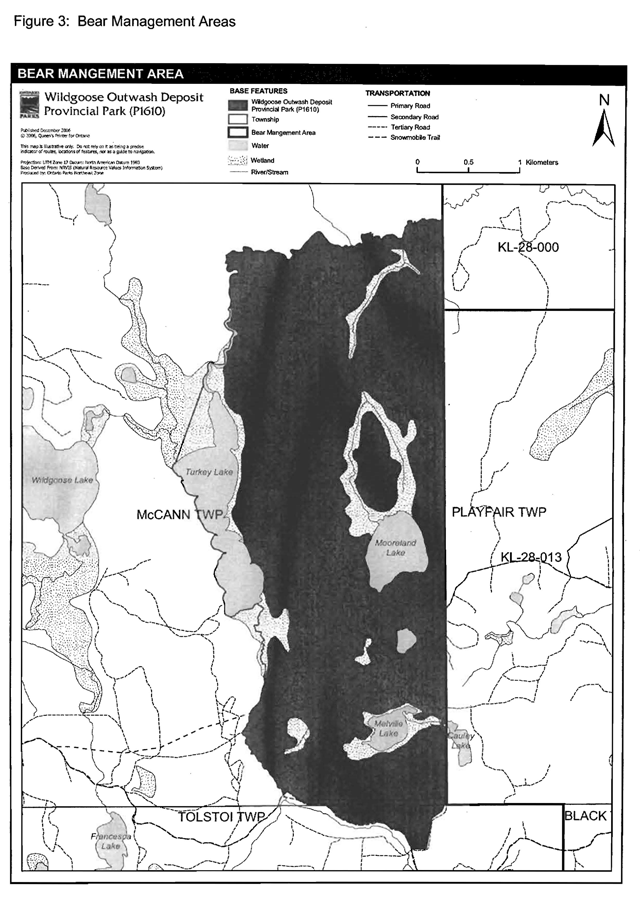
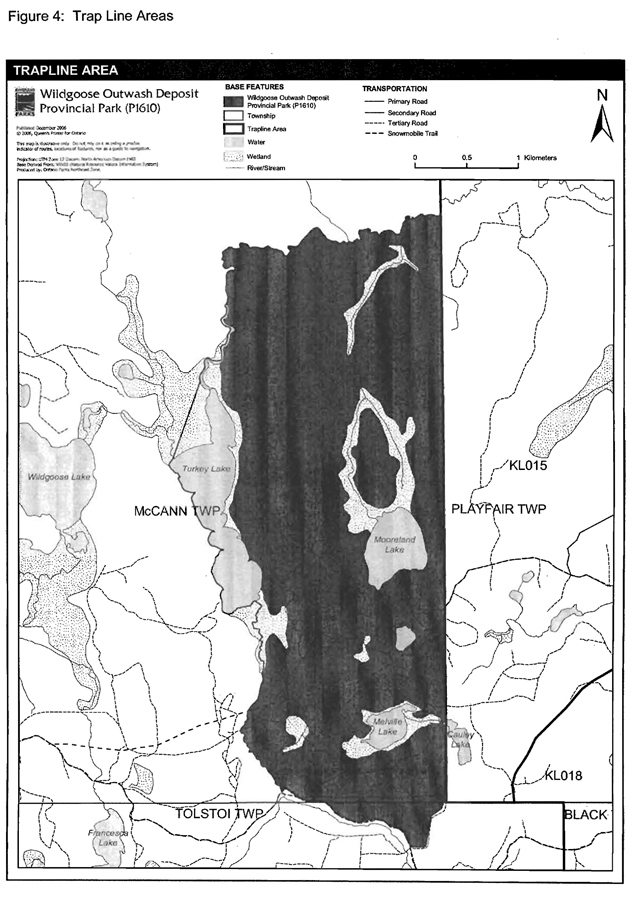
5.1.3 Industrial resources
There are no existing mining claims within park. The mining and surface rights on all lands within the park have been withdrawn from staking under the Mining Act (1990). Mineral exploration and mineral extraction are not permitted in provincial parks (OMNR 1992).
Utility corridors
There are no utility corridors located within the boundary of the park.
All public utilities (e.g. gas pipelines, transmission lines, communications towers) must avoid park lands wherever possible. New utility corridor crossings may be necessary to maintain essential public services (OMNR 2004a).
Any future utility corridors proposed through the park, where park lands are unavoidable, will be reviewed on a case-by-case basis. Protection of park features and values will be priority and all requirements of the Environmental Assessment Act will be met.
Roads
Highway 11 provides general access to the area east of the park. The Watabeag Road extends south from Matheson to provide general access to the area west of the park. A network of secondary and tertiary roads provides access to the southern portion of the park from Highway 11 and the Watabeag road. These roads are not used for general forest access. Old forest access roads within the park are not authorized for motorized use.
Ontario Parks does not support the maintenance or upgrade of any roads within the park boundary. New roads will not be permitted in the park (OMNR 2004).
5.1.4 Adjacent land management
Forestry
The lands adjacent to Wildgoose Outwash Deposit Provincial Park are located in the Nighthawk Forest (to the north, south and west) and the Timiskaming Forest (to the east) Management Units (FMU’s). The Nighthawk Forest is an amalgamation of the Driftwood Forest, Timmins Forest and Timmins Management Units. The Nighthawk Forest is currently managed by Abitibi-Consolidated under a Sustainable Forest License (#550587). The current forest management plan (FMP) for this management unit is to be renewed in 2008. The Timiskaming Forest Alliance Inc. currently holds the Sustainable Forest Licence (#542247) for the Timiskaming Management Unit. A new FMP was implemented for this forest management unit in 2006.
General use area
There are two General Use Areas adjacent to Wildgoose Outwash Deposit Provincial Park: Englehart Management Unit and Watabeag Lake.
Englehart Management Unit General Use Area (G1815) is 217,062 ha in size. The area is accessed by Highway 66 West, Highway 560, and forest access roads, particularly the Englehart Management. Unit Roads (North and South). The intent of this area is primarily to provide for resource extraction activities, mainly forestry. Other extractive activities and general recreation activities such as cottaging and canoeing are secondary uses.
Watabeag Lake General Use Area (G1857) is 19,190 ha in size. Access to this area is provided by forest access roads from Matheson in the north and Highway 66 in the south. Dominant features are Watabeag Lake a number of small cold water and warm water lakes, and extensive sand, gravel and reforested areas. The intent of this area is to provide for a combination of public recreation, cottaging and commercial tourism. Water storage for hydroelectric power generation is also a significant priority.
5.1.5 Land disposition
New land disposition for the private use of individuals or corporations will not be permitted (OMNR 1992; 2000).
Land use permits, licenses of occupation, unauthorized occupations
There are no existing land use permits (LUP), private land holdings, licenses of occupation (LO) or unauthorized occupations within the park.
Patent land
There are no patent lands with the park boundary.
Boat caches
There are no authorized boat caches within this provincial park. Boats are not permitted to be left unattended in the park without written permission from the superintendent under the authority of the Provincial Parks Act.
Recreational trails
There are currently no authorized trails within the park boundary. New trails (e.g. hiking) may be developed if the need arises (OMNR 2004a). Any proposed development within the park is subject to Environmental Assessment Act requirements.
5.2 Aquatic ecosystems
Sustaining high quality water resources is fundamental to the protection of park and adjacent land values. The MOE enforces applicable legislation and regulations pertaining to water quality.
5.2.1 Water management
There are no existing water control structures within Wildgoose Outwash Deposit Provincial Park. Hydroelectric developments are not permitted within the park (OMNR 1992; 2000; 2004a).
5.2.2 Fisheries management
The park contains four lakes, wetlands and a section of the Wildgoose River.
Fisheries management activities will be aimed, wherever possible, at the maintenance and enhancement of native, self-sustaining fish populations (OMNR 1992; 2004a).
Non-native fish species will not deliberately be introduced into the waters contained within the park (OMNR 1992; 2004a).
Sport fishing
Sport fishing is permitted within Wildgoose Outwash Deposit Provincial Park (OMNR 1992; 1999; 2004a). Any sport fishing activity is governed by the legislation and regulations in the Fish and Wildlife Conservation Act, as well as the Fisheries Act (1985). The Recreational Fishing Regulations Summary contains more information regarding general regulations and exceptions to these regulations for the area of this park.
Commercial fishing
There are no commercial fishing operations within Wildgoose Outwash Deposit Provincial Park.
New operations will not be permitted (OMNR 1992; 2004a).
Commercial baitfish harvesting
McCann (KL 1336) and Tolstoi (KL 2043) townships are currently allocated for baitfish harvesting. The license for McCann Township states that harvesting is not permitted within park waters. The baitfish license for Tolstoi Township does not make mention of waters in the park.
Bait fishing is not a permitted in this nature reserve class park. The portion of Tolstoi Township baitfish license (KL 2043) within the park boundary will be removed from the baitfish license.
Fish Stocking
Fish stocking is not permitted in the park (OMNR 1992).
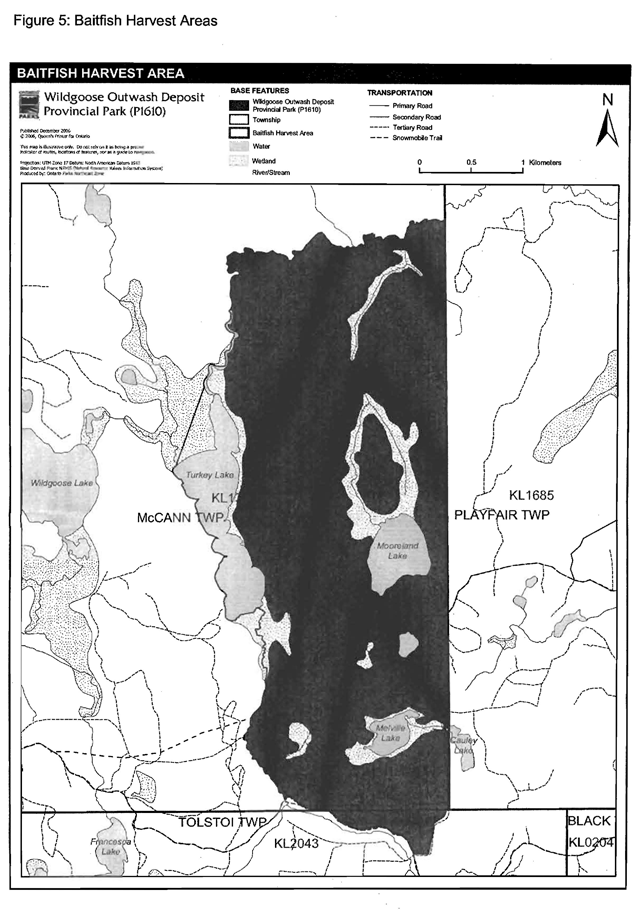
6.0 Operations policies
6.1 Recreation management
6.1.1 Motorized recreation
Motorboats
Motorized watercrafts are not permitted on the waters contained within the boundary of this provincial park (OMNR 1992; 2004a).
Aircraft
Aircraft landings are not permitted within the park (OMNR 1992; 2004a).
Snowmobiles and all terrain vehicles
There is low use of the tertiary road network within the park by snowmobiles. There is currently one authorized local snowmobile trail (L82) that predated park establishment and at least one unauthorized trail that extends into the park (Matheson Trail Masters snowmobile trail). There are no authorized ATV trails located within the park. The tertiary road network within the park receives some use by ATVs. This use may be authorized by the park superintendent.
Future discussions involving Ontario Parks, the Kirkland Lake district MNR office, and local snowmobile trail clubs will determine approaches to discontinue the use of snowmobiles within Wildgoose Outwash Deposit Provincial Park.
Proposals for new trails will not be considered through this park.
Off-trail use of snowmobiles and ATVs is prohibited.
6.1.2 Non-motorized recreation
Camping
Overnight camping and the development of campground or campsite facilities are not compatible with nature reserve policies (OMNR 1992; 2004a).
Hiking
There are no authorized hiking trails within the park.
Unauthorized hiking trails and other non-mechanized trails may be permitted to continue unless such trails threaten park features and values, create user conflicts or raise safety and/or liability issues.
If there is an identified need, the development of new hiking trails may be considered. Trail infrastructure to protect park values and features will be permitted. Any trail development within the park is subject to Environmental Assessment Act requirements.
Canoeing/kayaking
The park is not on a canoe route. Canoeing or kayaking may occur associated with the park lakes and may be allowed to continue, unless park features and values are threatened. Long-term management direction will be determined through future park planning (OMNR 2004).
6.1.3 Emerging recreational uses
There are emerging recreational uses for which there is no or limited policy to deal with their management (e.g. adventure racing, geocaching, etc.). The park superintendent will use legislation, policy and guidelines that are in place in the interim to manage emerging uses.
6.2 Development
There is no existing park infrastructure within this park. Any proposed development within the park will only be considered through future park management planning. Any proposed development is subject to the requirements of the Environmental Assessment Act.
6.3 Commercial tourism
Infrastructure for commercial tourism does not exist within the park.
Commercial tourism is not compatible with the nature reserve classification of this park (OMNR 1992). New commercial tourism dispositions (i.e. commercial LUPs) will not be issued within the park (OMNR 2004a).
7.0 Cultural resources
The management of any cultural resources will be directed toward identification, protection, and heritage appreciation (OMNR 1992). Cultural resource surveys of Wildgoose Outwash Deposit Provincial Park have not been completed to date.
8.0 Heritage education
Literature and other supporting information may be developed to describe the park in the context of Ontario’s provincial park system. Boundary limits significant heritage features and permitted uses of the waterway park may be included in park literature.
Prospective park visitors may be informed about the sensitivity and significance of park values through park literature.
9.0 Research
Scientific research by qualified individuals which contributes to the knowledge of natural and cultural history and to environmental and recreational management may be encouraged in the park. Ontario Parks will encourage institutions to undertake research projects. All research programs will require the prior approval of Ontario Parks and will be subject to park policy and other applicable legislation. Ontario Parks may approve the research of any natural or cultural features or values by qualified researchers. Any materials removed will remain the property of MNR.
Approved research activities and facilities will be compatible with the park’s protection objective. Any site, which is affected, will be rehabilitated as closely as possible to its original state. Environmental assessment requirements will apply.
Research must contribute to the knowledge of natural and cultural history and to environmental and recreational management. It must be non-consumptive in order to protect park features and values.
10.0 References
Aikins, M., 2003. Natural Hernage Area- Life Science Checksheet: Wildgoose Outwash Deposit Provincial Park (P1610). Ontario Ministry of Natural Resources.
Blackburn, C., 2004. Earth Science Report: Detailed Information for Site 1610 Wildgoose Outwash. Ontario Ministry of Natural Resources
Carré, K. 2002. OLL Implementation Database: Wildgoose Outwash Deposit Provincial Park (P1610). Ontario Ministry of Natural Resources.
Carré, K., 2003. Recreation Assessment: Wildgoose Outwash Deposit Provincial Park. Ontario Ministry of Natural Resources.
Davidson, R.J., 1981. A Framework for the Conservation of Ontario’s Earth Science Features. Ontario Ministry of Natural Resources, Toronto, 262p.
Environmental Assessment Act, 1990.
Fisheries Act, 1985.
Fish and Wildlife Conservation Act, 1997.
Frey, E. and D. Duba, 2003. Earth Science Report: P1610 Wildgoose Outwash Deposit Provincial Park. Ontario Ministry of Natural Resources.
Geomatics International Inc., 1998. Life Science Gap Analysis for Site District 3E-3. Prepared for the Ontario Ministry of Natural Resources.
Mining Act, 1990.
Ontario Ministry of Natural Resources, 1974. A Topical Organization of Ontario History. Historic Sites Branch Division of Parks.
Ontario Ministry of Natural Resources, 1992. Ontario Provincial Parks Planning and Management Policies.
Ontario Ministry of Natural Resources, 1999. Ontario’s Living Legacy Land Use Strategy.
Ontario Ministry of Natural Resources, 2000. Ontario Provincial Park Policy as Amended by the Ontario Living Legacy Land Use Strategy.
Ontario Ministry of Natural Resources, 2001. Public and Aboriginal Consultation Document Form Ontario’s Living Legacy Protected Area Boundary Refinement Review- Wildgoose Outwash Deposit Provincial Park (P1610).
Ontario Ministry of Natural Resources, 2004a. Crown Land Use Policy Atlas.
Ontario Ministry of Natural Resources, 2004b. Forest Fire Management Strategy for Ontario. Aviation and Fire Management Branch.
Ontario Ministry of Natural Resources, 2005. A Class Environmental Assessment for Provincial Parks and Conservation Reserves.
Provincial Parks Act, 1990.
Ritchie, G. and J.E. Thompson, 1998. Natural Heritage Assessment 3E-3 Summary Sheet. Prepared for the Ontario Ministry of Natural Resources, Northeast Regional Office, South Porcupine, Ontario.
Appendix A: Background information
Name: Wildgoose Outwash Deposit Provincial Park
Proposed class: Nature Reserve
Site district: 3E-6
OMNR administrative region/district/area: Kirkland Lake
Total area: 1,198 ha
Regulation date: April 2005 (O. Reg. 180/05)
Representation
Earth science
Wildgoose Outwash Deposit Provincial Park is located within the western Abitibi Subprovince of the Archean Superior Province, and in the northernmost area of the Cobalt Embayment of the Huronian Supergroup of the Southern Province.
The bedrock of the park consists mainly of basalt flows of the Kinojevis North supracrustal assemblage of the Abitibi greenstone belt. Cobalt Group conglomerate of the Huronian Supergroup occupies 20% of the park. A smaller area contains a diabase intrusion of uncertain affinity.
The north half of the park is overlain by sandy ground moraine till. The till was deposited by the southward advancing Superior Lobe of the Late Wisconsinan continental ice sheet approximately 11,000 years ago. The till in the southern half of the park is overlain or replaced by deltaic sand. These glaciofluvial sediments were deposited approximately 9,500 years ago into preglacial Lake Barlow, during the northward recession of the Superior Lobe (Blackburn 2004).
Life science
The park is dominated by even-aged stands of birch, spruce, Jack pine and poplar. Fourteen landform vegetation types have been identified. The park contains four lakes and the area is drained by the Wildgoose River. Wetlands in the area are characteristically associated with muskeg, tamarack, cedar, fens and spruce bogs. Moose and coolwater fisheries habitats exist in the area (Aikins 2003).
Cultural heritage
There are currently no reports describing the cultural heritage of Wildgoose Outwash Deposit Provincial Park.
Recreation and tourism
The park’s lakes, wetlands and forest communities provide the potential for a variety of recreation pursuits to occur within the park. These activities include hiking, nature viewing, solitude, photography, and fishing. All terrain vehicles and snowmobiles are known to use the tertiary roads within the park.
Inventories
Earth Science Reconnaissance: Blackburn, 2004
Life Science Reconnaissance: Alkins, 2003
Cultural Reconnaissance: [no information provided]
Recreational Reconnaissance: Carré, 2003